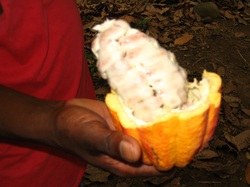Facts about the significance of the cacao plant in culture

Quick Facts:
•Cacao trees were depicted in sculptures associated with Mayan ruins in Central America.
•Cacao was a gift of nature, offered in rituals as food to the gods whom controlled rainfall (which would ensure the success of these people’s crops).
•Within the prehistoric Central American culture, cacao also was on the tribute lists to be paid as tribute to the region’s powerful rulers.
•Not only was the cacao used for consumption, but also as treasure.
•Cacao was so significant and central to Mayan society that during the Classic period, the third of the final three rulers at the ancient city of Tikal in Guatemala, the Peten region, was called Lord Cacao.
•Shows great importance it served within this culture and others throughout the world.
The cacao plant came out of the tropical rain forest and came into human history because of the prurient nature of human beings. It is “an ancient bridge between natural and human history” (Young 1). It is believed that back when the cacao plant was first discovered between 10,000 and 2000 B.P., ancient peoples invaded the lowland rain forests of the Amazon Basin and were attracted to the ripe yellow or red cacao pods. They also most likely observed different animals that would open the pods and feed on the tasty mucilaginous pulp encasing the seeds. Later on, pods were transported from South America into Central America.
Cacao was of great importance in the lives of ancient people because cacao trees would be depicted in sculptures associated with Mayan ruins in Central America. To the prehistoric Mesoamericans, “the cacao tree was the epithet of the Earth’s treasures and spiritually represented a bridge between Earth and the heavens” (Young 12). Cacao was a gift of nature, offered in rituals as food to the gods whom controlled rainfall (which would ensure the success of these people’s crops). Basically, it is an overall important component of Mesoamerican culture and commerce. Within the prehistoric Central American culture, cacao also was on the tribute lists to be paid as tribute to the region’s powerful rulers. Sometimes cacao would be tribute across great distances to various rulers, such as being as far away as “Soconusco in southeastern Chiapas, the most distant Aztec tributary province” (Young 19). Generally, not only was the cacao used for consumption, but also as treasure. Interestingly, cacao was so significant and central to Mayan society that during the Classic period, the third of the final three rulers at the ancient city of Tikal in Guatemala, the Peten region, was called Lord Cacao. This shows a great importance that the cacao plant serves within this and other cultures throughout the world.
•Cacao trees were depicted in sculptures associated with Mayan ruins in Central America.
•Cacao was a gift of nature, offered in rituals as food to the gods whom controlled rainfall (which would ensure the success of these people’s crops).
•Within the prehistoric Central American culture, cacao also was on the tribute lists to be paid as tribute to the region’s powerful rulers.
•Not only was the cacao used for consumption, but also as treasure.
•Cacao was so significant and central to Mayan society that during the Classic period, the third of the final three rulers at the ancient city of Tikal in Guatemala, the Peten region, was called Lord Cacao.
•Shows great importance it served within this culture and others throughout the world.
The cacao plant came out of the tropical rain forest and came into human history because of the prurient nature of human beings. It is “an ancient bridge between natural and human history” (Young 1). It is believed that back when the cacao plant was first discovered between 10,000 and 2000 B.P., ancient peoples invaded the lowland rain forests of the Amazon Basin and were attracted to the ripe yellow or red cacao pods. They also most likely observed different animals that would open the pods and feed on the tasty mucilaginous pulp encasing the seeds. Later on, pods were transported from South America into Central America.
Cacao was of great importance in the lives of ancient people because cacao trees would be depicted in sculptures associated with Mayan ruins in Central America. To the prehistoric Mesoamericans, “the cacao tree was the epithet of the Earth’s treasures and spiritually represented a bridge between Earth and the heavens” (Young 12). Cacao was a gift of nature, offered in rituals as food to the gods whom controlled rainfall (which would ensure the success of these people’s crops). Basically, it is an overall important component of Mesoamerican culture and commerce. Within the prehistoric Central American culture, cacao also was on the tribute lists to be paid as tribute to the region’s powerful rulers. Sometimes cacao would be tribute across great distances to various rulers, such as being as far away as “Soconusco in southeastern Chiapas, the most distant Aztec tributary province” (Young 19). Generally, not only was the cacao used for consumption, but also as treasure. Interestingly, cacao was so significant and central to Mayan society that during the Classic period, the third of the final three rulers at the ancient city of Tikal in Guatemala, the Peten region, was called Lord Cacao. This shows a great importance that the cacao plant serves within this and other cultures throughout the world.
